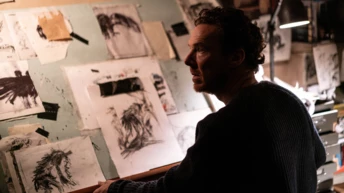
Save this storySave this storySave this storySave this story You’re currently perusing the Goings On dispatch, an index of what we’re experiencing, vibing with, and undertaking. Subscribe to have it delivered directly.
You’re currently perusing the Goings On dispatch, an index of what we’re experiencing, vibing with, and undertaking. Subscribe to have it delivered directly.
With the dawning of November comes early evening darkness, and let’s not forget the chill—yet various venues throughout the metropolis this winter will radiate both illumination and warmth. Should you crave some affection, the snug period presents a multitude of opportunities, such as Bradley Cooper’s cinematic endeavor “Is This Thing On?,” situated within the realm of comedic performances; the extravagant serenading of the alternative country icon Brandi Carlile; the premiere housewives of television, specifically those hailing from Salt Lake City; and, for those inclined towards the eerie, Tracy Letts’s suspenseful “Bug,” gracing the Broadway stage, starring his spouse, Carrie Coon, as a solitary waitress. Alvin Ailey introduces multiple fresh works to its customary residency at City Center, alongside a restaging by the admired Judith Jamison; the Met Opera assures grand theatricals in “Porgy and Bess” (taking place in 1920s Charleston) and “Andrea Chénier” (Paris during the French Revolution); and, in the world of art, Helen Frankenthaler, Joan Mitchell, and Louise Bourgeois, accompanied by sculptor Carol Bove and painter Ceija Stojka, will each enjoy their moment to shine.
New Yorker subscribers receive entry to our comprehensive seasonal cultural synopses directly in their email. We appreciate your backing.—Shauna Lyon
Navigate to: Television | Art | The Theatre | Movies | Dance | Contemporary Music | Classical Music
Television
 “Game of Thrones” Prequel, Female-Centric Universes
“Game of Thrones” Prequel, Female-Centric Universes
For the prior half-dozen years, the winter’s television focal point has remained “The Real Housewives of Salt Lake City,” a program that has breathed new vigor into the enduring reality series through imaginative insults, investigations into episodes of religious suffering, and the memorably deranged attire sported by ladies determined to wear sky-high stilettos in snowy conditions. (Season 6 is ongoing; John Oliver, of HBO’s “Last Week Tonight,” remarked of “R.H.O.S.L.C.,” “I’m not certain if there’s a more amusing program on TV, and my profession is comedy.”) It comes as no surprise, therefore, that “Salt Lake” has spurred imitation. The similarly constructed—albeit less successful—“The Secret Lives of Mormon Wives” makes its return to Hulu for season three on Nov. 13, while a deeper probe into episodes of spiritual maltreatment will be staged by Bravo’s “Surviving Mormonism with Heather Gay” (Nov. 11), with the “R.H.O.S.L.C.” luminary serving as host.
Switching gears to scripted material, this season boasts a plentiful array of imposing maternal characters. Claire Danes headlines “The Beast in Me” (Netflix; Nov. 13), acting the part of a woman grieving the vehicular death of her sole offspring, who finds herself ensnared by a predatory entrepreneur (Matthew Rhys) sensing the shadows she harbors towards the youth she deems responsible for her son’s passing. Danes’s persona mirrors Sarah Snook’s frantic mother in Peacock’s “All Her Fault” (Nov. 6), a nail-biter centered around the disappearance of a young boy, igniting suspicion among the women sharing his world. The complexities of motherhood heighten further in Kurt Sutter’s Western epic “The Abandons” (Dec. 4), wherein a woman (Lena Headey) inhabiting Oregon in the 1850s establishes an impromptu kinship with four orphans, while battling a mining heiress (Gillian Anderson) angling to seize their territory.
Unity is a prevalent motif. BritBox’s “Riot Women” (Oct. 22), crafted by Sally Wainwright of “Happy Valley,” presents a collective of women amidst the change of life battling the customary invisibility linked to their age group by launching a rock ensemble. A flashier form of sisterhood rises in “All’s Fair” (Nov. 4), Ryan Murphy’s flamboyant courtroom romp for Hulu—starring Glenn Close, Naomi Watts, and, naturally, Kim Kardashian—spotlighting discontented spouses and the team of female divorce litigators dedicated to securing their rightful share.
Intriguingly, the incoming months’ offerings slanted towards male perspectives adopt a historical bent. Michael Shannon and Matthew Macfadyen stand off, portraying President James Garfield and his attention-seeking assassin, Charles Guiteau, respectively, in Netflix’s “Death by Lightning” (Nov. 6). PBS grants the Revolutionary War the Ken Burns touch with “The American Revolution,” a six-part, twelve-hour documentary premiering on Nov. 16. Then, the dawning year will bring another “Game of Thrones” preliminary: the modestly dubbed “A Knight of the Seven Kingdoms” (Jan. 18). Peter Claffey embodies the humble Ser Duncan the Tall in the HBO production, who gains a squire in the form of a Targaryen prince. The series’ promotional material hints at a lighterhearted narrative, yet, in Westeros, jesting turns grim when somebody sacrifices a limb in a disturbing fashion.—Inkoo Kang
Art
 Mozart’s Artifacts, Native American Painting
Mozart’s Artifacts, Native American Painting
Several legendary venues are orienting towards fashion for a wintry lift this season. The Hispanic Society takes the lead with “Spanish Style: Fashion Illuminated, 1550-1700” (opening Nov. 6), which makes use of ensembles, illustrated documents, memorial effigies, etc., to scrutinize how attire and sway entwined in Early Modern Spain. The Frick Collection offers a complement with “Gainsborough: The Fashion of Portraiture” (Feb. 12), ferrying onlookers to eighteenth-century England so that they may evaluate Thomas Gainsborough’s sensitive representations through societal and substantial lenses. And the Metropolitan Museum of Art delves into a principal attraction—nineteenth-century Western Europe—to find instances of “Fanmania” (Dec. 11), a craze involving handheld fans that period artists took to heart.
Should your craving for European antiquity on the brink of innovation persist, the Morgan Library & Museum offers “Wolfgang Amadeus Mozart: Treasures from the Mozarteum Foundation of Salzburg” (March 13). The exhibit, a partnership with the establishment entrusted with preserving Mozart’s heritage, places the composer in his own setting via his personal instruments, correspondence, and belongings—all journeying to New York for the first occasion. If sonic environments better suit your tastes than concentrated study, check out Cooper Hewitt, Smithsonian Design Museum’s “Art of Noise” (Dec. 12; however, note that the museum is shuttered at present due to the federal-government cessation). The presentation presents an assortment of sonic creations, spanning Haight-Ashbury gig posters to initial jukeboxes and tailored listening chambers.
Within contemporary art, a duo of museums persist in throwing a long-overdue spotlight on the work of Indigenous creatives. “Clearly Indigenous: Native Visions Reimagined in Glass,” found at the National Museum of the American Indian (Nov. 15, though this museum likewise remains closed on account of the federal government closure), surveys the manners through which Native virtuosos have appropriated the medium—a narrative which, oddly enough, begins with the populist and kitsch artist Dale Chihuly. Grey Art Museum is mounting “Irrititja Kuwarri Tjungu: Contemporary Aboriginal Painting from the Australian Desert” (Jan. 22), gathering one hundred and thirty-four introspective and cosmic works conceived by the affiliates of Papunya Tula Artists, Australia’s pioneer cooperative for Aboriginal art, established in 1971.
In parallel, four eminent figures within contemporary creation are being granted solo presentations, most notably “Helen Frankenthaler: A Grand Sweep,” hosted at the Museum of Modern Art (Nov. 18). Strangely, the miniature retrospective occupies the museum’s sizable atrium, which might render it challenging to fully value the nuances of Frankenthaler’s pigment-laden abstractions. David Zwirner observes one of her confreres within Abstract Expressionism via “To Define a Feeling: Joan Mitchell, 1960-1965” (Nov. 6), centering on a spell when Mitchell prioritized centrally placed color configurations on her canvases, spurred on by her Mediterranean sojourn. In adjacent Chelsea galleries, Hauser & Wirth features abstract works by Louise Bourgeois steeped in psychology during “Gathering Wool” (Nov. 6), while Pace displays a recent series by Agnes Martin brimming with levity through “Innocent Love” (Nov. 7).
After according its ongoing Rashid Johnson exhibition an extended run, the Guggenheim hosts Carol Bove (March 5), whose structures constructed from scrap metal ought to whimsically punctuate the rotunda. Yet the title of season’s most opportune exhibition goes to the Drawing Center’s “Ceija Stojka: Making Visible” (Feb. 20). Stojka, a self-taught artist, commenced creating art around the age of sixty, channeling her upbringing as a Roma person and encounters surviving the Holocaust. The presentation compiles her canvases and drawings alongside archival content to unspool a narrative both sobering and uplifting.—Jillian Steinhauer
The Theatre
 British Romance, Carrie Coon in “Bug”
British Romance, Carrie Coon in “Bug”
Winter makes a gentle entrance onto Broadway; therefore, only a scant few productions creep in after autumn’s frenzy. The two-character British musical “Two Strangers (Carry a Cake Across New York)” (Longacre; commencing previews Nov. 1), conceived by Jim Barne and Kit Buchan, makes a transatlantic hop in hopes of a romantic splash; the celebrated June Squibb takes the stage in Jordan Harrison’s pensive 2014 sci-fi play “Marjorie Prime” (Hayes; Nov. 20); short-story architect Simon Rich’s anthology showcase “All Out: Comedy About Ambition” presents a revolving roster of premier comics (Nederlander; Dec. 12); and the revival of “Bug,” Tracy Letts’s 1996 fright fest, stars Namir Smallwood and the magnificent Carrie Coon, satisfying her theater pangs after an extensive absence (Friedman; Dec. 17).
Off Broadway, much-loved performers appear within recognized narratives: Michael Urie acts as the unseated “Richard II” (Astor Place Theatre; in previews, opens Nov. 10), in Craig Baldwin’s Shakespeare adaptation, as the playwright Alex Lin modernizes a divergent Shakespearean catastrophe for “Laowang: A Chinatown King Lear” (59E59; Nov. 1), casting the extraordinary Cindy Cheung as a restaurant operator embroiled in a succession conundrum. Nicholas Braun and two-time Tony victor Kara Young co-star in Rajiv Joseph’s poisonous 2012 love story, “Gruesome Playground Injuries” (Lucille Lortel; Nov. 7); Lucas Hnath’s iteration of Molière’s “Tartuffe” showcases multiple Tony winners, spanning Matthew Broderick and Francis Jue (New York Theatre Workshop; Nov. 14); and five-time Oscar contender Michelle Williams embarks upon Eugene O’Neill’s most rigorous romance, the 1921 masterpiece “Anna Christie” (St. Ann’s Warehouse; Nov. 25).
To combat the wintry nip, consider the highly innovative output amongst the experimental vanguard: Else Went’s “Initiative,” a five-hour marathon exploring adolescence, unfolds starting Nov. 4 at the Public; Hannah Kallenbach’s “Mikey Maus in Fantasmich” satirizes a certain squeaky emblem at the Brick from Nov. 7; Philip Venables and Ted Huffman’s musical version of Larry Kramer’s 1977 novel “The Faggots and Their Friends Between Revolutions” (Park Avenue Armory; Dec. 2) makes its New York arrival; and the gonzo collective Das Besties unveils their dance-theater study into addiction, “Das Rauschgift” (Box of Moonlight; Dec. 4). Festivals comprising Under the Radar (Jan. 7-25), Prototype (Jan. 7-18), and the Exponential Festival (Jan. 5-Feb. 8) equally ignite the forthcoming year—each one an embarrassment of options.
Looking ahead to 2026, our playwrights tackle political themes, if veiled: Shakespeare’s play of clandestine coup attempts “The Tragedy of Coriolanus” may feel disconcertingly pertinent (Polonsky Shakespeare Center; Feb. 1); Lauren Yee premieres “Mother Russia” (Signature; Feb. 3), a spy dramedy depicting intra-Russian monitoring following the fall of the Soviets; Wallace Shawn reunites with his “My Dinner with André” compatriot, André Gregory, who helms Shawn’s play “What We Did Before Our Moth Days,” which revolves around fondness and middle-class principles, featuring Hope Davis and John Early (Greenwich House; Feb. 4); and the scribe Anna Ziegler adapts Sophocles’ magnum opus with “Antigone (This play I read in high school),” starring Tony Shalhoub as Creon and Celia Keenan-Bolger as the central revolutionary (Public; Feb. 26).
The inception of March witnesses two star vehicles driving onto Broadway: John Lithgow portrays an assailed Roald Dahl in the West End import “Giant,” by Mark Rosenblatt (Music Box; March 11), and the endearing tough guys from “The Bear,” Jon Bernthal and Ebon Moss-Bachrach, partner for “Dog Day Afternoon,” a Stephen Adly Guirgis adaptation of the Sidney Lumet film chronicling a 1972 bank heist (August Wilson; March 10). From this moment forward, the Broadway calendar spirals, due to the imperative of launching many performances ahead of the Tony cutoff date in late April—amongst other indications, Guirgis’s suspense production will act as the spring season’s starting signal.—Helen Shaw
Movies
 A Shakespeare Story, a Ping-Pong Champion
A Shakespeare Story, a Ping-Pong Champion
The frosty season promises music, beginning with Stephen Schwartz’s contributions to “Wicked: For Good” (Nov. 24), the sequel to the previous year’s “Wicked: Part One,” with Jon M. Chu directing both. Cynthia Erivo returns as Elphaba—presently dubbed the Wicked Witch of the West—while Ariana Grande takes up her role as Glinda, now Glinda the Good. “Merrily We Roll Along” (Dec. 5), led by Maria Friedman, is a motion-picture capture of Stephen Sondheim’s Tony-awarded 2023 Broadway production (originally staged in 1981), exploring the weaving fates of three companions—as glimpsed over two decades, in reverse—starring Daniel Radcliffe, Lindsay Mendez, and Jonathan Groff. Within Óliver Laxe’s “Sirāt” (Nov. 17), a Spaniard (Sergi López), in company with his young son (Bruno Núñez Arjona), roams the Moroccan desert in quest of his daughter, vanishing as she attended a rave there; this film offers a techno score penned by Kangding Ray. Mona Fastvold’s biographical drama “The Testament of Ann Lee” (Dec. 25), co-scripted with Brady Corbet, stars Amanda Seyfried as the eponymous Shaker preacher, who, circa 1774, left Manchester, England, to make her way to New York; it showcases choreography by Celia Rowlson-Hall together with compositions by Daniel Blumberg, patterned after Shaker chants.
Real-life virtuosos and their iconic output acquire screen focus. The titular figure within “Hamnet” (Nov. 27), Chloé Zhao’s rendering of a Maggie O’Farrell novel, is the son of William Shakespeare (Paul Mescal) and his spouse, Agnes (Jessie Buckley); the drama orbits the young one’s passing and Shakespeare’s composition of “Hamlet” in response. Craig Brewer’s “Song Sung Blue” (Dec. 25) is a bio-pic spun from a 2008 documentary of the same appellation, concerning Mike and Claire Sardina (Hugh Jackman and Kate Hudson), who performed as Neil Diamond impersonators under the banner Lightning & Thunder.
This season’s political imaginings embrace a spectrum of feelings. Throughout Kleber Mendonça Filho’s “The Secret Agent” (Nov. 26), unfolded predominantly in 1977 Brazil under dictatorial command, Wagner Moura features as a scientist targeted by the regime’s paramilitary forces while being assisted by an underground web of defiance. Toni Servillo stars in Paolo Sorrentino’s “La Grazia” (Dec. 5), playing a President of Italy grappling with crucial decisions before his term’s end, including whether to sanction a bill authorizing euthanasia. “Ella McCay” (Dec. 12), helmed by James L. Brooks, presents Emma Mackey as a lieutenant governor who ascends to the governor’s seat amidst familial discord; Jamie Lee Curtis and Woody Harrelson fill supporting positions. Within Park Chan-wook’s satirical comedy “No Other Choice” (Dec. 25), inspired by a Donald E. Westlake novel, an unemployed executive (Lee Byung-hun) turned down from employment decides to dispose of his rivals.
Romance endures as a catalytic force in cinema, such as in “Is This Thing On?” (Dec. 19), a comedic drama led by Bradley Cooper, wherein Laura Dern and Will Arnett enact a newly divided twosome maintaining a profound connection; Cooper also features in a supporting role as their friend. “Marty Supreme” (Dec. 25), Josh Safdie’s first venture following “Uncut Gems,” channels that picture’s frenetic dynamism, as a 1952 period piece, regarding a table-tennis hustler (Timothée Chalamet) sustaining links with a duo of women (Odessa A’zion and Gwyneth Paltrow) as he sets his sights upon a world championship. Jodie Foster stars in Rebecca Zlotowski’s melodrama “A Private Life” (Jan. 16), cast as a Parisienne psychologist who rekindles ties with her former spouse (Daniel Auteuil) seeking to affirm that a deceased patient was done in.—Richard Brody
Dance

Pam Tanowitz’s Bucolic Piece, Ailey Interprets Joni Mitchell
During bleak January, summer makes a fleeting yet welcomed visit via Pam Tanowitz’s “Pastoral” (Rose Theatre; Jan. 11-13). It’s a rustic piece, a tranquil realm of peaceful, albeit quirky, dances positioned within a scenery crafted by the artist Sarah Crowner, showcasing vividly colored fabric panels. Dancers travel with refreshing clarity as Beethoven’s “Pastoral” Symphony murmurs across Caroline Shaw’s musical melange, hinting equally at buzzing insects, birdsong, rain.
Mild breezes pass through Maija García’s fresh dance piece meant for the Alvin Ailey American Dance Theatre (New York City Center; Dec. 3-Jan. 4). “Jazz Island” marks the Cuban American choreographer’s inaugural endeavor alongside the Ailey dancers, after dedicating extensive time to Broadway (“FELA!”) and motion pictures (“BlacKkKlansman”). It gleans its stimulus from a folktale focused upon the Haitian vodou goddess of affection, Erzuli, compiled throughout a series of narratives by the late dancer Geoffrey Holder, “Black Gods, Green Islands.” Alicia Graf Mack’s debut term as artistic director, plentiful with fresh works, further incorporates the return of Judith Jamison’s expressive duet “A Case of You.” This personal dance utilizes the eponymous Joni Mitchell tune, rendered via a heartfelt recording delivered by Diana Krall.
Incoming calls and birdsong compete when it comes to grabbing attention inside John Cage’s musical composition for Merce Cunningham’s playful “Travelogue,” originating in 1977. The Trisha Brown Dance Company (BAM; Feb. 26-28) enacts this humorous, surreal dance piece—marking their premiere foray through Cunningham’s repertory—adjacent to Brown’s “Set and Reset,” a chic, tempting piece stemming from 1983, rendered all the more striking through Laurie Anderson’s silvery vocal-and-electronic score “Longtime No See.” Both sets encompass distinguished designs conceived by Robert Rauschenberg: a video collage and scrims on behalf of “Set and Reset,” bicycle tires as well as seats for “Travelogue.”
Both of New York City Ballet’s assigned choreographers, Justin Peck plus Alexei Ratmansky, will generate fresh pieces for the winter term (David H. Koch Theatre; Jan. 20-March 1). After centering attention upon modern music, Peck is adapting Beethoven’s “Eroica”; in parallel, Ratmansky dives into satire through a revived version of the 1936 ballet “Le Roi Nu,” which owes its inspiration to Hans Christian Andersen’s fable “The Emperor’s New Clothes.” The term further marks the advent of cherished efforts incorporating George Balanchine’s melancholic “Diamonds” (keep a watchful eye trained on the dancer Mira Nadon). Furthermore, a rarity: Jerome Robbins’s hushed “Antique Epigraphs,” a dance showcasing eight females set to enigmatic Debussy, stimulated through a selection of Roman effigies, cast from bronze alongside enamel eyes, housed at the Archeological Museum inside Naples.—Marina Harss
Contemporary Music
Sourse: newyorker.com







